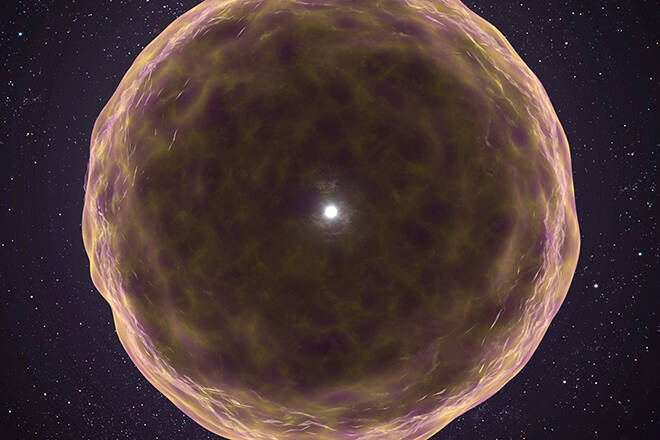Science
Astronomers Discover Unique Supernova 2 Billion Light-Years Away

Astronomers have identified a new type of supernova, designated SN 2021yfj, located approximately 2 billion light-years from Earth. This discovery, made possible by the collaborative efforts of researchers at the Zwicky Transient Facility in California and the W.M. Keck Observatory in Hawaii, reveals unprecedented insights into the life cycle of massive stars. The findings were published on March 15, 2025, in the journal Nature.
The research team, led by Steve Schulze, an astrophysicist from Northwestern University, determined that the supernova’s progenitor star had shed its outer layers before its explosive demise. Unlike typical supernovae, which distribute a mix of elements, SN 2021yfj demonstrated a distinct layered structure, resembling an onion. “We know of over 10,000 supernovae, but this one is very different,” Schulze noted.
The star that gave rise to SN 2021yfj was estimated to be around 60 times the mass of the Sun. As the star approached its end, it gradually expelled its outer layers, leaving a core rich in heavier elements such as silicon, sulfur, and argon. The team observed the moment the iron core exploded, illuminating the previously ejected material. This observation supports the long-held theory that stars possess a layered composition.
Despite the breakthrough, questions remain regarding the mechanism behind the star’s unique shedding of layers. Schulze’s team suspects that violent internal pulses might have played a role in stripping away material. However, the presence of helium in the remaining layers poses a puzzle. “It’s a fly in the soup that shouldn’t be there,” Schulze explained, emphasizing that helium should have been ejected long before the explosion.
Possible explanations for the helium’s presence include the influence of a companion star that may have disturbed the layers or the existence of powerful jets that could have dredged material from the star, although no such jets were detected.
Historically, supernovae are classified into two primary types: Type I, which lack hydrogen, and Type II, which contain hydrogen. SN 2021yfj represents a new classification, referred to as Type 1en. Schulze remarked, “The properties of this supernova are so unusual that there is no object even remotely similar.”
The team estimates that occurrences of extreme stripping like that observed in SN 2021yfj might be rare, with perhaps one in 1,000 supernovae undergoing similar processes. Most supernovae appear similar unless examined in detail, which makes discoveries like this particularly fortunate. “There was a lot of luck involved in making this discovery,” Schulze added.
Looking ahead, astronomers expect to identify more Type 1en supernovae using advanced telescopes, such as the upcoming Vera C. Rubin Observatory in Chile. Scheduled to begin operations later this year, the observatory aims to conduct a decade-long survey of the universe, potentially uncovering thousands of supernovae daily. “Rubin is going to detect thousands of supernovae every day,” said Anya Nugent, an astrophysicist at the Harvard-Smithsonian Center for Astrophysics and a contributor to an accompanying article. The excitement surrounding these discoveries underscores the ongoing quest to understand the universe and the origins of the elements that comprise our very existence.
-

 Lifestyle3 months ago
Lifestyle3 months agoLibraries Challenge Rising E-Book Costs Amid Growing Demand
-

 Sports3 months ago
Sports3 months agoTyreek Hill Responds to Tua Tagovailoa’s Comments on Team Dynamics
-

 Sports3 months ago
Sports3 months agoLiverpool Secures Agreement to Sign Young Striker Will Wright
-

 Lifestyle3 months ago
Lifestyle3 months agoSave Your Split Tomatoes: Expert Tips for Gardeners
-

 Lifestyle3 months ago
Lifestyle3 months agoPrincess Beatrice’s Daughter Athena Joins Siblings at London Parade
-

 World3 months ago
World3 months agoWinter Storms Lash New South Wales with Snow, Flood Risks
-

 Science3 months ago
Science3 months agoTrump Administration Moves to Repeal Key Climate Regulation
-

 Science2 months ago
Science2 months agoSan Francisco Hosts Unique Contest to Identify “Performative Males”
-

 Business3 months ago
Business3 months agoSoFi Technologies Shares Slip 2% Following Insider Stock Sale
-

 Science3 months ago
Science3 months agoNew Tool Reveals Link Between Horse Coat Condition and Parasites
-

 Sports3 months ago
Sports3 months agoElon Musk Sculpture Travels From Utah to Yosemite National Park
-

 Science3 months ago
Science3 months agoNew Study Confirms Humans Transported Stonehenge Bluestones









